Since the publication of the NACTO Urban Bikeway Design Guide, NACTO has released additional guidance on facility selection where goals include high-comfort or all-ages bicycling.
See this new resource >
Description
Volume Management measures reduce or discourage thru traffic on designated bicycle boulevard corridors by physically or operationally reconfiguring select corridors and intersections along the route. On roadways with shared travel lanes such as bicycle boulevards, motor vehicle traffic volumes significantly impact bicyclist comfort . Higher vehicle volumes decrease comfort and may lead to a greater potential for conflicts, as well as a loss of perceived safety. Bicycle boulevards should be designed for motor vehicle volumes under 1,500 vehicles per day (vpd), with up to 3,000 vpd allowed in limited sections of a bicycle boulevard corridor. Read More+
On a 20 mph street with 1,000 vpd, a cyclist traveling at 12 mph during peak hour would be passed by a car traveling in the same direction approximately every 86 seconds (assuming peak hour is 15 percent of vpd, the street is two-way with 70% of traffic volumes traveling in the peak direction, and cars are evenly spaced along the street). By comparison, at 3,000 vpd, a bicyclist would be passed by a car every 29 seconds, and at 5,000 vpd, a bicyclist would be passed by a car every 17 seconds.
If the street already has volumes under 1,500 vpd, then volume management measures may be needed to maintain existing low volumes. In the case where a bicycle boulevard passes through a commercial or industrial area, reducing motor vehicle volumes below 1,500 may not be possible or beneficial for the area. If volumes are below 3,000 vpd, additional signs and markings can be used to improve visibility of the bicycle boulevard, and speed management can be used to maintain low speeds. Bicycle boulevards with motor vehicle volumes over 1,500 vpd may be less attractive to families with children and other people who do not prefer riding in traffic, although they can make a decent commuter connection. If volumes are over 3,000 vpd for a short segment of the bicycle boulevard corridor, a bike lane or cycle track may be considered through the area to maintain a low-stress bikeway.
If intervention is needed to reduce or maintain low motor vehicle volumes along the corridor, volume management treatments can prohibit motor vehicle turning or through movements while allowing passage by bicyclists and pedestrians. Such treatments should be implemented with consideration for emergency vehicles and neighborhood access.
Volume management techniques include the following:
- A forced turn at an intersection restricts through movements for motor vehicles. This diversion can exclusively use signs to allow buses and emergency vehicles to continue straight, but this may result in poor compliance by motorists (Berkeley Bicycle Boulevard Design Tools and Guidelines, 2000).
- A channelized right-in/right-out island forces motor vehicles to turn right while bicyclists can continue straight through the intersection. The island can provide a through bike lane or bicycle access to reduce conflicts with right-turning vehicles.
- Partial closures or choker entrances across one direction of traffic at an intersection allow full bicycle passage while restricting vehicle access to one side only. Motorists on the bicycle boulevard must turn onto the cross street while bicyclists may continue straight along a short contra-flow bike lane past the closure.
- Median islands/diverters restrict through vehicle movements while providing refuge for bicyclists to cross one direction of traffic at a time (also see major street crossing treatments). A snake diverter is a narrow raised median that is an extruded curb along the centerline of the cross street. This treatment minimizes impacts for travelers on the cross street while prohibiting through movements by motor vehicles on the bicycle boulevard.
- Diagonal diverters placed at a four-way minor intersection require all motor vehicle traffic to turn, while allowing bicyclist and pedestrian through movements. Read More+
Diagonal diverters should provide a 6- to 10-foot refuge area for crossing bicyclists to wait for a gap in traffic, which is forced to turn across the feature.
- Full diverters create a “T” that blocks motor vehicles from continuing on a bicycle boulevard, while bicycle travel can continue unrestricted. Full closures can be constructed to be permeable to emergency vehicles.
Click on the images below to view 3D concepts of volume management treatments.
Treatment details can be accessed below under design guidance.
Volume Management Benefits
- Reduces motor vehicle volumes by completely or partially restricting through traffic on a bicycle boulevard. Read More+
- Establishes and reinforces bicycle priority by restricting vehicle through movements.
- Improves bicyclist comfort on a corridor and benefits pedestrians and residents by reducing traffic volumes along the corridor.
- Provides opportunities for landscaping, stormwater management, and other community features such as benches and message boards.
Typical Applications
- Along target streets on which reductions in motor vehicle volumes are needed to meet the volume thresholds for bicycle boulevards (i.e., below 1,500 vpd preferred; 3,000 vpd maximum). Bicycle boulevards may be designated along short segments of roadways that accommodate traffic volumes above the established threshold, if necessary, to complete the corridor. Above 1,500 vpd, speeds should be low and additional signs used to increase visibility of the bicycle boulevard. Above 3,000 vpd, a bike lane, cycle track, or other treatments can be considered where speed or volume management treatments cannot reduce volumes below the threshold.
- Along streets where conversion to a bicycle boulevard may otherwise encourage cut-through traffic through the removal of stop signs.
- At the intersection of two bicycle boulevards.
Design Guidance
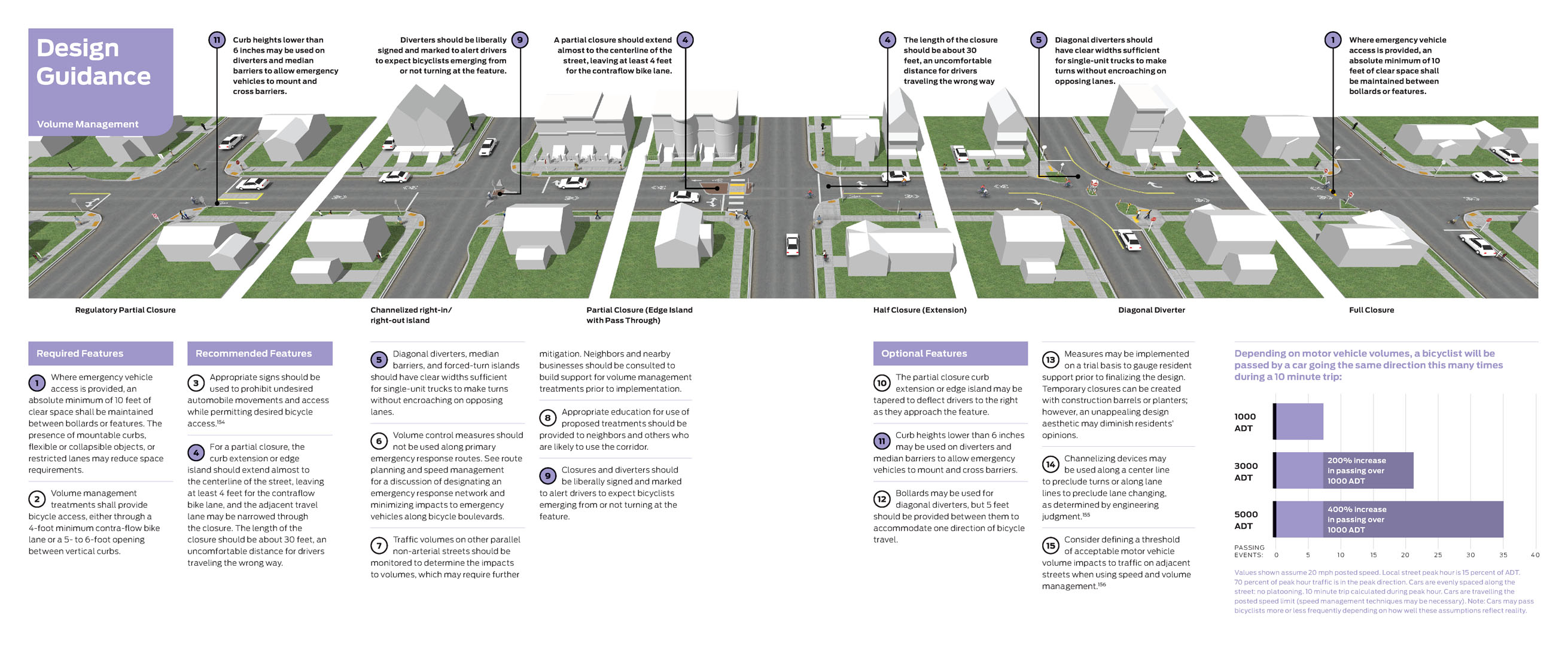
Click the image above to see the guidance summary page full screen.
| Required Features |
 |
Where emergency vehicle access is provided, an absolute minimum of 10 feet of clear space shall be maintained between bollards or features. The presence of mountable curbs, flexible or collapsible objects, or restricted lanes may reduce space requirements. |
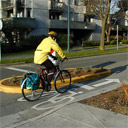 |
Volume management treatments shall provide bicycle access, either through a 4-foot minimum contra-flow bike lane or a 5- to 6-foot opening between vertical curbs. |
| Optional Features |
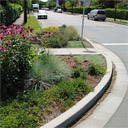 |
The partial closure curb extension or edge island may be tapered to deflect drivers to the right as they approach the feature. |
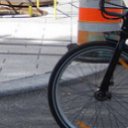 |
Curb heights lower than 6 inches may be used on diverters and median barriers to allow emergency vehicles to mount and cross barriers. |
 |
Bollards may be used for diagonal diverters, but 5 feet should be provided between them to accommodate one direction of bicycle travel. |
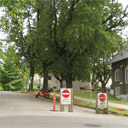 |
Measures may be implemented on a trial basis to gauge resident support prior to finalizing the design. Temporary closures can be created with construction barrels or planters; however, an unappealing design aesthetic may diminish residents’ opinions. |
 |
Channelizing devices may be used along a center line to preclude turns or along lane lines to preclude lane changing, as determined by engineering judgment.
Read More+
“Channelizing devices, as described in Sections 6F.63 through 6F.73, and 6F.75, and as shown in Figure 6F-7, such as cones, tubular markers, vertical panels, drums, lane separators, and raised islands, may be used for general traffic control purposes such as adding emphasis to reversible lane delineation, channelizing lines, or islands. Channelizing devices may also be used along a center line to preclude turns or along lane lines to preclude lane changing, as determined by engineering judgment”
Federal Highway Administration. (2009). Manual on Uniform Traffic Control Devices. 3H.01.
|
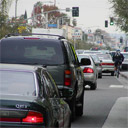 |
Consider defining a threshold of acceptable motor vehicle volume impacts to traffic on adjacent streets when using speed and volume management.
Read More+
The threshold can consider total traffic volume; an increase of over 400 vpd on a local street may be unacceptable, and the resulting traffic volume on any local street should not exceed 3,000 vpd.
City of Portland. (2011). Impact Threshold Curve.
|
Maintenance
- In winter climates, these treatments can be challenging to keep clear of snow and debris. Careful consideration should be applied within the design process to minimize impacts to snow removal operation. Special maintenance may be required to keep bicycle pass-throughs clear of snow and debris.
- Vegetation should be regularly trimmed to maintain visibility and attractiveness.
Treatment Adoption and Professional Consensus
Volume management techniques are used by many jurisdictions as part of neighborhood traffic calming programs.